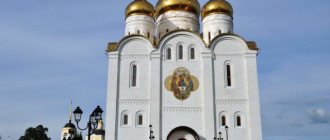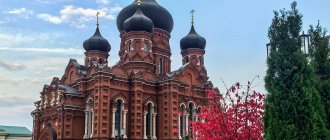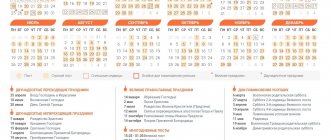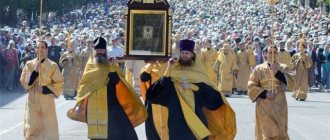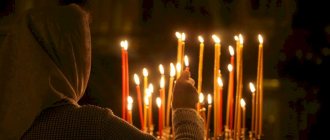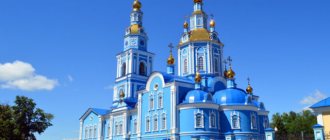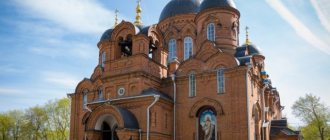| Ekaterinburg St. John the Baptist Cathedral |
Ekaterinburg and Verkhoturye diocese
of the Ekaterinburg Metropolis of the Russian Orthodox Church
- Diocesan administration: Russia, 620086, Ekaterinburg, st. Repina, 6a
- Tel., 228-15-25, 233-59-60, fax: 242-46-62
- Official site:
- Canonical territory: Verkhoturye GO; Aramilsky, Artinsky, Achitsky, Berezovsky, Bisertsky, Verkhnepyshminsky, Degtyarsky, Yekaterinburg, Irbitsky, Krasnoufimsky, Makhnevsky, Pervouralsky, Polevsky, Revdinsky, Rezhevsky, Svobodny, Sredneuralsky, Staroutkinsky, Sysertsky, Ural and Shalinsky districts; Nizhneserginsky district, Sverdlovsk region
- Cathedrals: Trinity in Yekaterinburg, St. John the Baptist in Yekaterinburg
- On the map: Yandex.Map, Google map
The spread of Orthodoxy and the background of the diocese
Orthodoxy began to be practiced within the diocese with the arrival of Russian settlers here - approximately from the time of Ermak’s conquest of Siberia in 1581.
The Russian settlement of the Urals began from the north and gradually moved towards the southeast. In 1589, the first Russian city of Lozva (now Ivdel) was founded, in 1597 - Verkhoturye. In cities and settlements, when they were founded, churches were established, then monasteries appeared, of which the following are known: Pokrovsky and Nikolsky in Verkhoturye, Rozhdestvensky in Tagil, Epiphany Nevyansky, Dalmatovsky Uspensky on the Iset River. Initially, these lands were under the jurisdiction of the Vologda and Great Perm bishops. With the opening in 1620 of an independent Siberian diocese with a see in Tobolsk, the “trans-Ural” counties were included in it in 1621 and were part of it until 1799. On October 16, 1799, an independent diocese was established in Perm, which, along with others, included the Trans-Ural counties of the Perm province.
Ekaterinburg diocese before the revolution of 1917
On December 25, 1833, for the improvement of the vast Perm diocese, a vicariate was established in it with a vicar bishop residing in Yekaterinburg. Of the five Trans-Ural districts of the Perm province, three were entrusted to the immediate jurisdiction of the vicar: Ekaterinburg, Kamyshlovsky and Shadrinsky. The cathedral was determined to be the Church of the Epiphany, with the former parish remaining attached to it.
In view of the “ inevitably encountered, due to the vastness of the Perm diocese and the significant population of the churches of God and the clergy serving them, great inconveniences and difficulties in managing the trans-Ural part of the Perm diocese, especially regarding clergy, improvement of parishes and measures against schism
“According to the Highest approved report of the Holy Synod, on January 29, 1885, the independent Ekaterinburg diocese was formed as part of Ekaterinburg, Shadrinsky, Kamyshlovsky, Verkhotursky and Irbitsky districts. By 1888, there were two theological schools and one women’s school in the diocese, as well as the Orthodox brotherhood of the Holy Righteous Simeon, the Verkhoturye Wonderworker, founded in 1886 with the goal of converting schismatics and sectarians and establishing the Orthodox faith, morality and enlightenment. The monasteries of the diocese were generally distinguished by the richness of their churches and sacristies.
Restoration of diocesan life
On February 22/23, 1993, an independent Kurgan diocese was separated from the diocese, within the Kurgan region, after which the Yekaterinburg department cared for the territory of the Sverdlovsk region.
In 2005, the diocese established the “Orthodox Tele.”
Due to the large number of parishes, on July 27, 2011, the Nizhny Tagil and Kamensk-Ural dioceses were separated from the diocese. The Ekaterinburg department remained under the jurisdiction of Aramilsky, Artinsky, Achitsky, Berezovsky, Bisertsky, Verkhnepyshminsky, Degtyarsky, Ekaterinburgsky, Irbitsky, Krasnoufimsky, Makhnevsky, Pervouralsky, Polevsky, Revdinsky, Rezhevsky, Svobodny, Sredneuralsky, Staroutkinsky, Sysertsky, Ural and Shalinsky districts and Nizhny Novgorod. Eserginsky district in the southwest, as well as the city of Verkhoturye in the center of the Sverdlovsk region.
On October 6, 2011, the Ekaterinburg diocese became part of the Ekaterinburg Metropolis.
Historical names
- Ekaterinburg (vicariate, December 25, 1833 - January 29, 1885)
- Ekaterinburg and Irbit (January 29, 1885 - 1924)
- Sverdlovsk and Zlatoust (1924 - 1926)
- Sverdlovsk and Irbit (1926 - 1943)
- Sverdlovsk and Chelyabinsk (November 27, 1944 - 1947)
- Sverdlovsk and Irbit (May 12, 1947 - December 9, 1958)
- Sverdlovsk and Kurgan (December 9, 1958 - September 25, 1991)
- Ekaterinburg and Kurgan (September 25, 1991 - February 22/23, 1993)
- Ekaterinburgskaya and Verkhoturskaya (from February 22/23, 1993)
Statistics
- 1885, at the opening of the diocese - 446 churches and 450 chapels, Orthodox population 1,312,469 people, Old Believers 55,822 people.
- 1912 - 575 churches, 680 chapels and houses of worship; 13 monasteries (10 women’s); 2 theological schools, 1 diocesan women's school, 385 church schools; 5 almshouses, 3 shelters, 2 hospices.
- January 1, 1958 [1] - 46 registered temples/houses of worship.
- mid 2011 [2] - approx. 530 parishes
- January 2012 - 232 parishes, 346 clergy (including 266 priests; 80 deacons), 320 monastics, 88 parochial schools.
Archpastors
Perm Vicariate
- Evlampy (Pyatnitsky) (February 11, 1833 - June 22, 1840)
- Anatoly (Martynovsky) (August 4, 1840 - June 10, 1841)
- Melchizedek (Zolotinsky) (August 6, 1841 - September 24, 1845)
- Jonah (Kapustin) (May 19, 1846 - November 21, 1859)
- Iriney (Bogolyubov) (January 17 - May 8, 1860)
- Varlaam (Denisov) (August 21, 1860 - May 19, 1862)
- Mitrofan (Vitsinsky) (May 28, 1862 - November 9, 1866)
- Vassian (Chudnovsky) (November 21, 1866 - September 9, 1876)
- Barsanuphius (Okhotin) (October 31 - November 19, 1876)
- Modest (Strelbitsky) (April 10, 1877 - December 9, 1878)
- Veniamin (Smirnov) (March 4, 1879 - April 5, 1882)
- Nathanael (Leandrov) (April 25, 1882 - January 29, 1885)
Independent diocese
- Nathanael (Leandrov) (January 29, 1885 - January 10, 1888)
- Kirill (Orlov) (1888) [3]
- Polycarp (Rozanov) (1888 - 1891)
- Afanasy (Parkhomovich) (November 8, 1891 - November 12, 1894)
- Simeon (Pokrovsky) (1894 - 1896)
- Vladimir (Shimkovich) (June 12, 1896 - June 2, 1897)
- Christopher (Smirnov) (June 6, 1897 - March 29, 1900)
- Irenaeus (Horde) (March 29, 1900 - March 28, 1902)
- Nikanor (Kamensky) (March 28, 1902 - November 26, 1903)
- Vladimir (Sokolovsky-Avtonomov) (November 29, 1903 - March 18, 1910)
- Mitrofan (Athos) (April 2, 1910 - March 20, 1914)
- Seraphim (Golubyatnikov) (1914 - 1917)
- Seraphim (Alexandrov) (1917) v/u
- sschmch. Hierotheus (Afonin) (September 27, 1923 - ?) high school, bishop. Shadrinsky
- Alexy (Buy) (1925) v/u, ep. Vitebsk
- Stefan (Znamirovsky) (1926 - September 29, 1927) v/u, ep. Shadrinsky
- Schisp. Victor (Ostrovidov) (October - December 23, 1927) v/u, ep. Shadrinsky
- Sschmch. Arkady (Ershov) (July 28, 1928 - January 23, 1929) high school bishop. Kungursky
- Valerian (Rudich) (1929 - 1930) high school bishop. Shadrinsky
- Eusebius (Rozhdestvensky) (1930) v/u, archbishop. Shadrinsky
- Valerian (Rudich) (1931) v/u, ep. Kirillovsky
- Alexy (Kuznetsov) (1931 - 1932) supreme, archbishop. Sarapulsky
- Sophrony (Arefyev) (March 22, 1932 - January 1933) high school, bishop. Irbitsky
- Makariy (Zvezdov-Makarov) (February 13 - March 8, 1933) supreme, archbishop. Irbitsky
- Gleb (Pokrovsky) (? - September 1935)
- Alexy (Kuznetsov) 2nd time (1935 - 1936) high school, archbishop. Sarapulsky
- Peter (Savelyev) (March 1936 - January 27, 1937) high school bishop. Kungursky
1937 - 1943 - remaining parishes under the authority of Patriarchal Locum Tenens Sergius (Stragorodsky)
- Pavel (Golyshev) (1958) v/u, ep. Permian
- Leonid (Polyakov) (July 7 - October 8, 1966) diocesan, bishop. Permian
- Ilian (Vostryakov) (November 1979 - August 8, 1980) v/u, ep. Solnechnogorsk
Diocesan departments
- financial and economic
- social service
- parochial schools
- cultural heritage
- on interaction with the armed forces and law enforcement agencies
- training
- missionary youth
- pilgrimage and excursion
- sports-patriotic
- for relations with public organizations
- sales
- catechetical
- personnel
- jewelry
- press service
- analytical service
- legal service
- offset printing house
- information and publishing center
Structure
To organize fruitful church, social and public activities, the diocese has a clear organization.
Archpastors
Since 2011, the Ekaterinburg diocese has been headed by Kirill, who has the title of Metropolitan of Ekaterinburg and Verkhoturye. Since the founding of the independent diocesan administration, it has been headed by 34 bishops. Particularly frequent changes of bishops occurred in the 20-30s. XX century, when the clergy were subjected to massive repression.
Cathedral of Ekaterinburg Saints
Two leaders of the diocese who died at the hands of the Bolsheviks were canonized. In 1997, Bishop Viktor Ostrovidov, who occupied the see in Yekaterinburg in October-December 1927, was glorified as a holy confessor. In 2000, Bishop Arkady Ershov, who carried out hierarchal service in the Middle Urals from July 1928 to January 1929, was glorified as a martyr. .
Deanery
In the Ekaterinburg diocese there are more than 200 parishes, which are part of the following deaneries:
- Pervouralskoe (Pervouralsk);
- Vsekhsvyatskoye (central administrative districts of Yekaterinburg);
- Ivanovskoye (eastern districts of the Yekaterinburg urban district);
- Preobrazhenskoye (northern areas of Yekaterinburg);
- Rozhdestvenskoye (districts located in the north-west of the regional center);
- Berezovskoye (southwestern districts of Yekaterinburg);
- Rezhevskoye (Rezhevsky district);
- Sysertskoye (urban district of the same name);
- Verkhnepyshminskoye (Verkhnyaya Pyshma town);
- Krasnoufimskoye (Krasnoufimsk);
- Nizhneserginskoe (city of Nizhnie Sergi);
- Polevskoye (Polevskoy urban district);
- Revdinskoye (Revda);
- Artinskoye (Artinsky district);
- Achinskoye (Achinsky district);
- Shalinskoye (Shalinsky district);
- Verkhoturskoye (Verkhotursky district).
Church on the Blood in Yekaterinburg
Monastic properties located in the diocese are included in a separate deanery.
Diocesan departments
Under the diocesan administration, departments have been formed that are in charge of certain areas of spiritual, social and public activity.
- The educational and educational department oversees the activities of Sunday and Orthodox schools, conducts educational work in secular educational institutions at all levels, and also organizes the education of parishioners in churches.
- The Canonization Commission is engaged in collecting, studying and disseminating information about the companions of the faith, the new martyrs who suffered during the years of Soviet power. With the help of departments involved in publishing activities and interaction with the media, the collected materials become available to the general public.
- The scope of activity of the missionary department includes disseminating the Word of God among unchurched Christians, explaining the foundations of Orthodoxy and the meaning of church sacraments. In addition to their main activities, missionaries are engaged in confrontation with sects and various totalitarian cults.
Metropolitan Kirill - head of the Yekaterinburg diocese - The youth and sports-patriotic department oversees the issues of attracting representatives of the younger generation to the Church. Clergy and volunteers organize teams participating in social and sports projects of the diocese. Together with secular authorities, the departments participate in the organization of various cultural, sports and social events.
- The church administration has independent departments that deal with interaction with security and military government agencies, as well as with the Cossacks.
- The department for promoting sobriety, combating drug addiction and various addictions conducts conversations and events aimed at helping addicted people and their relatives.
- The pilgrimage department organizes pilgrimage trips within the diocese, as well as to holy places in Russia and abroad.
- The financial, economic and architectural departments are responsible for economic activities. Legal issues that arise during the activities of various departments are resolved by the legal service.
Social institutions
The Social Ministry Department conducts several social programs aimed at helping socially vulnerable categories of the population:
- support for the work of the center for the socialization of homeless people “Derzhava”;
- Orthodox sisterhood helps patients, their relatives and employees of local medical institutions;
- maintenance of the Novo-Tikhvin orphanage for girls;
- financing centers for the rehabilitation of addicted people;
- organizing a charity canteen for needy and homeless people.
Educational establishments
- Verkhoturye Theological School
- Yekaterinburg Theological Seminary
- Yekaterinburg Teachers' Seminary
- PSTGU Distance Learning Center
- Theological Faculty of the Russian State Vocational Pedagogical University of Yekaterinburg
- Department of Theology, Ural Institute of Business
- Inactive:
- Ekaterinburg Theological School (since 1833, inactive)
- Ekaterinburg Diocesan School (since 1880, inactive)
Shrines
There are many shrines on the territory of the diocese. The most famous are the following objects:
- Church on the Blood, built on the site of the execution of the family of the last Russian Tsar Nicholas II Romanov.
- Holy Cross Monastery, which houses a piece of the Holy Cross.
- The relics of St. Simeon of Verkhoturye, kept in the St. Nicholas Monastery.
- The Ural Icon of the Mother of God, found in 2003. It is kept in the St. Nicholas Church in Yekaterinburg.
Social institutions
- Charitable Foundation "Mercy"
- Orthodox charity canteen
- Diocesan Hospice Service
- Orthodox funeral service
- Maternity Protection Center "Cradle"
- Rehabilitation Center for Victims of Non-Traditional Religions
- Society "Sobriety"
- City night house
- Almshouse and patronage service
- Hotel Ganina Yama
- Diocesan Orthodox Library
- Help for Orthodox migrants
- Orthodox medical and social rehabilitation center
- Rehabilitation center for drug addicts
Churches and temples, monasteries
There are 232 parish churches and 8 monasteries on the territory of the diocese. The main religious buildings are St. John the Baptist and Trinity Cathedrals, located in Yekaterinburg.
Alexander Nevsky Novo-Tikhvin Monastery in Yekaterinburg
Monastic life is conducted in the following monasteries:
- St. Nicholas Monastery in Verkhoturye;
- Verkhoturye Women's Intercession Monastery;
- Kostylevskaya Kosminskaya hermitage;
- Royal Monastery on Ganina Yama;
- Novo-Tikhvin Convent;
- Sarsinsky Bogolyubsky Convent;
- Holy Cross male monastic community in Yekaterinburg;
- Sredneuralskaya Mother of God convent.
Literature
- Shestakov, I., priest, Anniversary book for the clergy, published on the occasion of the 100th anniversary (1799-16 October 1899) of the Perm diocese: With the attachment of addresses of the clergy of the Perm and Yekaterinburg dioceses
, Perm, 1899. - Srebryansky, P. P., Reference book of the Ekaterinburg diocese for 1909
, Ekaterinburg, 1909. - Novikov, N. N., Bishops of Perm and Yekaterinburg: (Chronological information).
Proceedings of the Perm Scientific Archival Commission , 1903, issue. 6, 156-158. - Parishes and churches of the Ekaterinburg diocese: Historical and statistical description
, Ekaterinburg, 1902, IV. - Voroshilin, S.I., Temples of Yekaterinburg
, Yekaterinburg, Uralmedizdat, 1995. - Lavrinov, V., prot., Ekaterinburg diocese: Events.
People. Temples , Ekaterinburg, Ural University Publishing House, 2001.
Mass media
The Ekaterinburg diocese carries out active missionary work. The Word of the Lord is spread not only among local parishioners, but also at the national level through the following media:
- radio "Resurrection";
- Soyuz TV channel;
- magazine "Ekaterinburg Diocesan Gazette";
- youth newspaper "Pokrov";
- weekly "Orthodox Herald".
Complete information about religious life in the region is available on the official website on the Internet.
